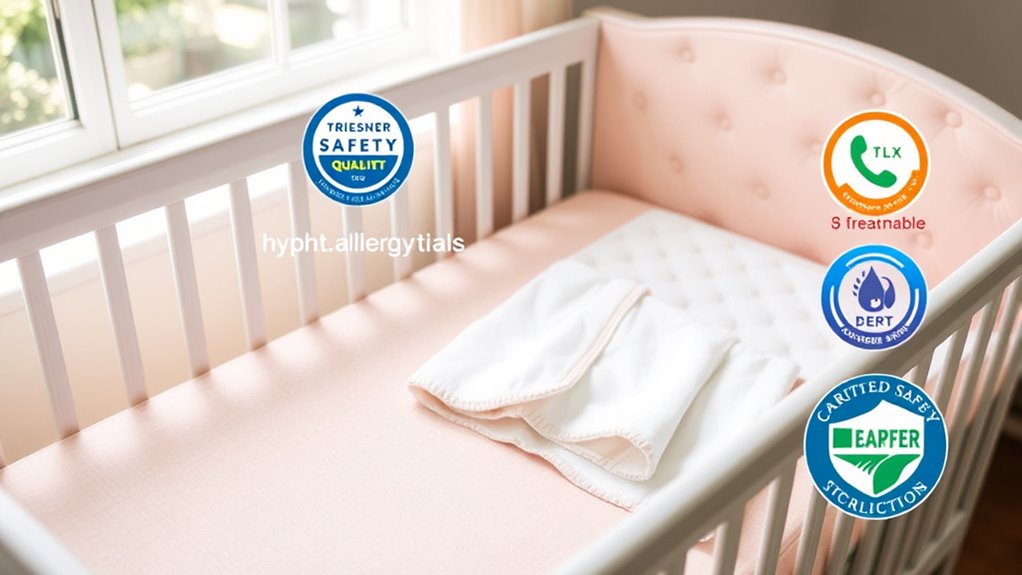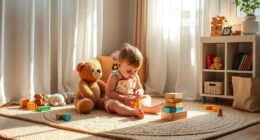To guarantee your baby sleep gear is safe, look for certifications from trusted organizations like JPMA, CPSC, and GREENGUARD. These labels show the product meets safety and chemical standards, giving you peace of mind. Check for proper labels, manufacturer info, and adherence to regulations like ASTM and European safety standards. Understanding what these marks mean helps you choose safer options for your little one. Keep exploring to learn more about verifying safety certifications.
Key Takeaways
- Recognize safety certification labels like JPMA, ASTM, and CPSC to verify compliance with safety standards.
- Ensure labels are visible, legible, and include manufacturer details, certification date, and standard marks.
- Understand industry standards that set requirements for design, materials, and testing to minimize hazards.
- Confirm products meet safety certifications like GREENGUARD for low chemical emissions and healthier sleep environments.
- Read safety labels carefully, check for age and weight limits, and research brand safety reputation before purchasing.
Understanding Safety Certification Labels

Understanding safety certification labels is essential because they indicate whether a baby sleep gear item meets established safety standards. When shopping, always check for labels from reputable organizations like the Juvenile Products Manufacturers Association (JPMA) or those with the “Certified by” mark. These labels show that the product has undergone testing for safety, stability, and materials. Look closely at the label to verify the certification’s legitimacy; counterfeit labels can be misleading. Keep in mind that labels often include information about the manufacturer, date of certification, and standards met. Recognizing these details helps you select safe and reliable sleep gear, reducing risks for your baby. Always prioritize certified products to ensure you’re providing a secure sleeping environment. Additionally, understanding safety certification labels can help you stay informed about the latest standards and recalls in the industry.
The Role of ASTM International Standards

ASTM International standards play a essential role in ensuring the safety of baby sleep gear by providing clear, scientifically-backed guidelines for manufacturers to follow. These standards set specific requirements for design, materials, and testing procedures, helping to minimize risks like suffocation, entrapment, and chemical exposure. When a product complies with ASTM standards, you can trust it has undergone rigorous evaluation to meet safety benchmarks. Manufacturers often use these guidelines to develop and improve their products, ensuring consistency across the industry. ASTM standards also facilitate innovation by establishing a common safety language. As a parent, knowing that a sleep gear item aligns with ASTM standards offers peace of mind, confirming that it adheres to established safety protocols designed to protect your baby. Additionally, ethical hacking techniques are sometimes employed during product testing to identify vulnerabilities and ensure comprehensive safety evaluations.
The Significance of JPMA Certification
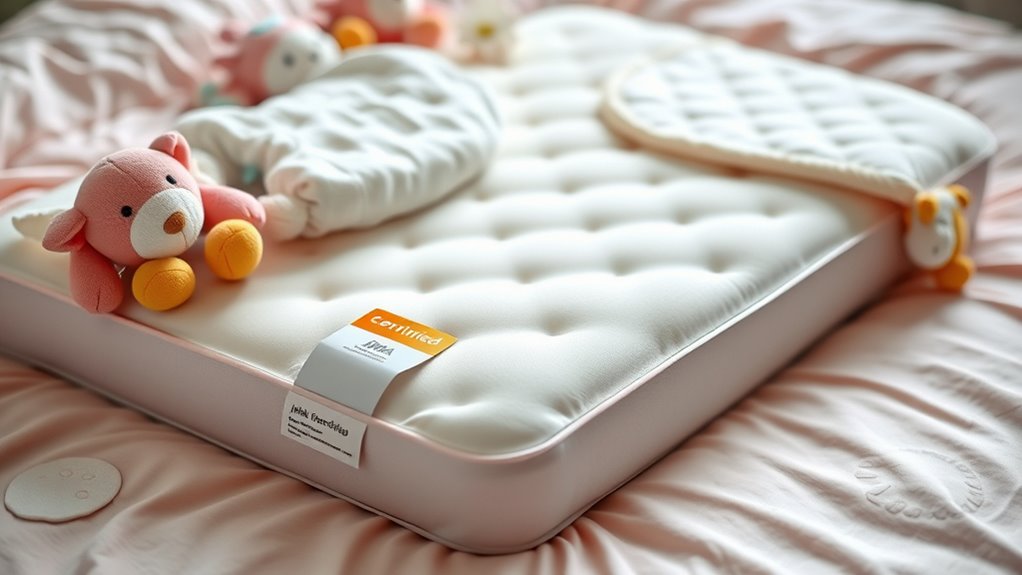
JPMA certification shows that baby sleep gear meets strict industry safety standards, giving you peace of mind. It also boosts your confidence in choosing products that prioritize your child’s well-being. Knowing a product is JPMA certified helps you make safer, more informed decisions for your baby. Being aware of cheating and related issues can also remind parents to stay vigilant about safety and trustworthiness in all aspects of caregiving.
Industry Safety Standards
Industry safety standards play an essential role in ensuring that baby sleep gear is safe and reliable for your little one. These standards set the minimum requirements manufacturers must meet to reduce hazards like choking, suffocation, or injury. When a product complies with industry standards, it indicates thorough testing and quality control. Organizations like the Juvenile Products Manufacturers Association (JPMA) develop these standards, emphasizing safety, durability, and non-toxic materials. By choosing gear that adheres to industry standards, you can feel confident that your baby’s sleep environment is designed with their safety in mind. It also helps you compare products easily, knowing they meet recognized safety benchmarks. Understanding product safety certifications enables you to make informed choices for your baby’s wellbeing. Ultimately, industry standards serve as a crucial safeguard, giving you peace of mind as you care for your baby.
Consumer Confidence Boost
When you see a baby sleep gear with JPMA certification, it instantly boosts your confidence in the product’s safety and quality. This certification shows the item has met rigorous safety standards, giving you peace of mind that it’s been thoroughly tested. Knowing a product is JPMA certified helps you avoid concerns about harmful chemicals, structural integrity, and overall safety. It reassures you that the manufacturer committed to meeting strict guidelines, reducing potential risks for your baby. This confidence allows you to focus on your baby’s comfort, knowing safety is a top priority. Ultimately, JPMA certification acts as a trusted badge, making it easier for you to choose sleep gear that’s safe, reliable, and backed by reputable standards. Additionally, a certification process that involves rigorous testing ensures that the product maintains high safety and quality standards throughout its lifespan.
Recognizing CPSC Compliance and Labels
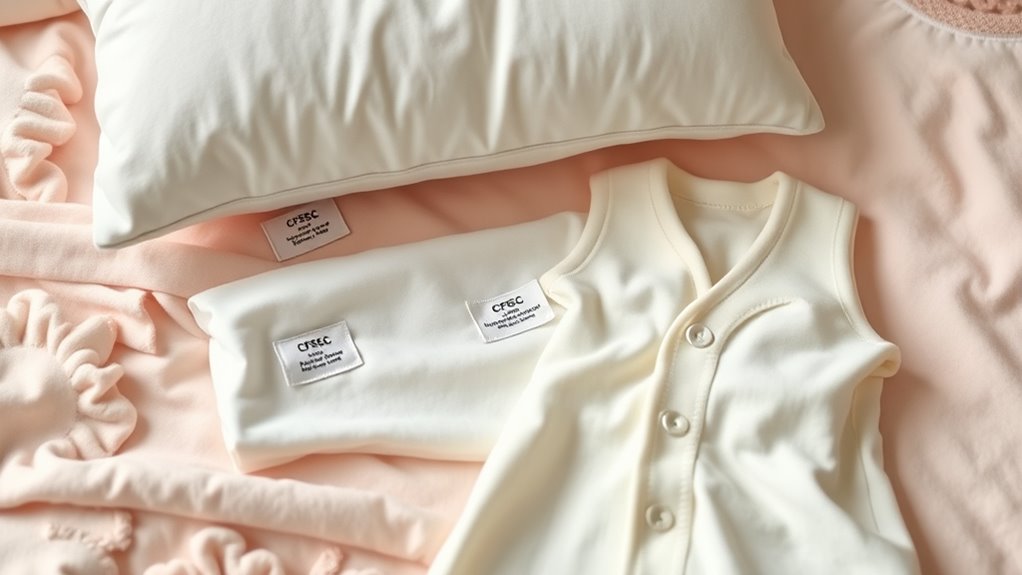
You should check the CPSC label to make sure it’s clearly visible on the sleep gear. Understanding the certification symbols helps you confirm the product meets safety standards. Always verify the product’s compliance to make sure it’s safe for your baby. Staying informed about safety standards is essential for protecting your child.
CPSC Label Visibility
To guarantee a baby sleep gear item is safe and compliant, check for the CPSC label’s visibility. A clear, easily accessible label indicates the product meets safety standards. Here’s what to look for:
- Ensure the label is firmly attached and not easily removed.
- Confirm it’s located in a visible spot on the product, not hidden or inside seams.
- Check that the label’s print is legible and not faded.
- Verify the label includes the CPSC logo or statement indicating compliance.
- Remember, market growth projected at over 40% CAGR in AI tech by 2025 highlights the importance of staying informed about product safety standards as technology advances.
If the label is missing, faded, or hard to find, it’s a red flag. Visibility confirms the product has passed safety regulations and helps you make informed choices for your baby’s safety.
Certification Symbols Meaning
Are you familiar with what certification symbols on baby sleep gear really mean? These symbols indicate that the product meets safety standards set by regulatory agencies like the CPSC. The most common symbol you’ll see is the “UL” mark, showing the product has been tested for electrical safety. Another key symbol is the “CPSC” label, confirming compliance with federal safety regulations for baby gear. Labels often include a date code or batch number, helping you verify the product’s manufacturing details. Recognizing these symbols ensures you’re choosing gear that adheres to safety standards, reducing risks for your little one. Always check for these marks before purchasing or using baby sleep gear to confirm it’s been tested and approved for safety. Additionally, verifying product safety certifications can provide extra assurance of quality and compliance.
Verifying Product Compliance
Recognizing CPSC compliance and labels is key to guaranteeing that your baby’s sleep gear meets safety standards. To verify compliance, look for clear labels indicating the product’s adherence to safety regulations. Here’s what to check:
- Confirm the presence of the CPSC label, which certifies the product’s safety.
- Ensure the label is firmly attached and not easily removable.
- Check that the label includes manufacturer details and a date of manufacture.
- Look for markings like “Meets ASTM standards” or other relevant safety certifications.
The Importance of GREENGUARD Certification
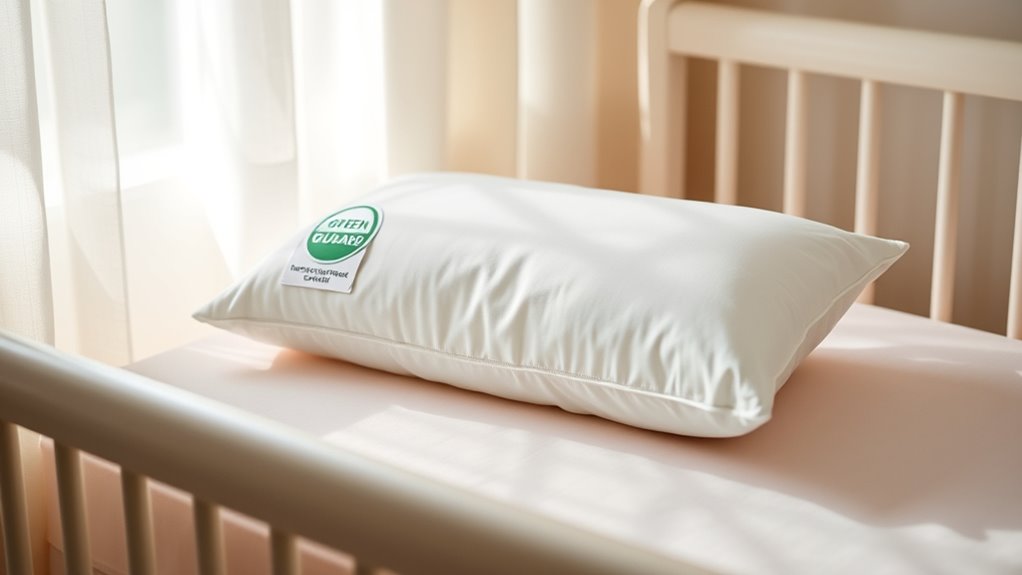
Because many baby sleep products are in close contact with your little one, ensuring they meet strict safety standards is essential. GREENGUARD Certification verifies that a product has been tested for harmful chemicals and emissions, promoting healthier indoor air quality. When a sleep product is GREENGUARD certified, you can be confident it contributes to a safer sleep environment by reducing exposure to volatile organic compounds (VOCs) and other toxins. This certification also indicates the manufacturer follows rigorous standards for low chemical emissions, which is vital for your baby’s developing lungs and immune system. Incorporating tableware safety standards into product selection emphasizes the importance of comprehensive safety considerations. Choosing GREENGUARD-certified sleep gear helps you prioritize safety and health, giving you peace of mind that your child sleeps in an environment that’s been thoroughly evaluated for indoor air quality and chemical safety.
European Safety Standards for Baby Sleep Gear

European safety standards for baby sleep gear set strict requirements to make certain products are safe, reliable, and free from harmful substances. These standards ensure that sleep gear meets high safety levels before reaching consumers. To achieve this, the regulations cover:
- Use of non-toxic, flame-retardant materials
- Adequate ventilation and breathability
- Secure fastening and absence of sharp edges
- Resistance to wear and tear over time
Manufacturers must test their products according to these criteria, ensuring safety during regular use. By complying with European standards, you can trust that the sleep gear you choose minimizes risks like suffocation, overheating, or chemical exposure. These standards help you confidently select safe, durable products for your baby’s sleep environment. Natural materials are often emphasized in eco-friendly options to promote safety and sustainability.
How to Read and Interpret Safety Labels

Safety labels on baby sleep gear provide essential information about the product’s compliance and safe use, so it’s important to know how to read them correctly. First, check for certification marks from trusted organizations, like JPMA or ASTM. These symbols confirm the product meets safety standards. Next, read the age and weight limits carefully to ensure the gear matches your baby’s size and developmental stage. Look for clear instructions on proper use, such as how to secure straps or avoid loose bedding. Pay attention to warning labels about potential hazards, like suffocation risks or loose parts. Finally, review the manufacturing date and batch number to track product recalls if needed. Understanding these labels helps you make informed choices and keeps your baby safe.
Tips for Verifying Product Safety Before Purchase
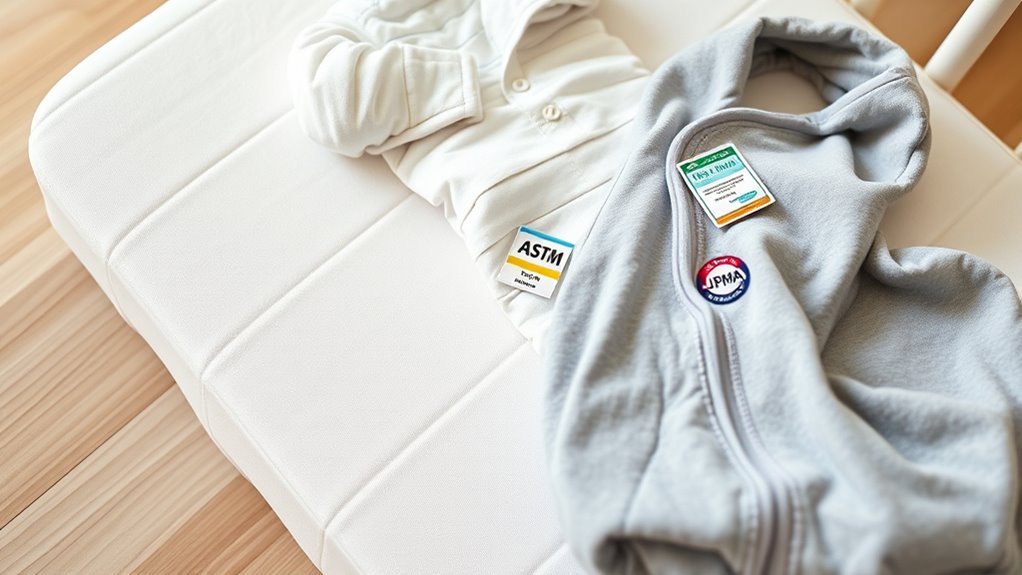
Before making a purchase, it’s important to verify that the baby sleep gear you’re considering meets safety standards. Here are some tips to help you do that:
- Check for official safety certifications like JPMA, ASTM, or CPSC labels.
- Research the brand’s reputation and read reviews from other parents.
- Inspect the product for any recalls or safety notices online.
- Confirm that the product complies with current safety regulations and standards.
Frequently Asked Questions
Are Uncertified Baby Sleep Gears Safe to Use?
You might wonder if uncertified baby sleep gear is safe. While it may seem okay, uncertified products haven’t been tested for safety standards, which increases the risk of hazards like suffocation or choking. To keep your baby safe, it’s best to choose sleep gear that meets recognized safety certifications. Always prioritize certified gear, follow manufacturer guidelines, and avoid any products that look suspicious or lack proper labels.
How Often Are Safety Standards Updated for Baby Sleep Products?
Imagine safety standards as a lighthouse guiding ships through changing waters. You might wonder how often these lighthouses are updated to keep ships safe. The truth is, safety standards for baby sleep products are revised periodically, often every few years, to adapt to new research and technology. Staying informed guarantees you’re steering your little one’s sleep environment correctly, helping prevent hazards and keeping your baby safe in a constantly evolving safety landscape.
Can a Product Have Multiple Safety Certifications Simultaneously?
You might wonder if a product can hold multiple safety certifications at the same time. The answer is yes; many products do. Manufacturers often seek various certifications to meet different safety standards or appeal to a wider audience. Having multiple certifications shows the product has been thoroughly tested and meets various safety requirements, giving you peace of mind that your baby’s sleep gear is as safe as possible.
Do Certifications Guarantee Absolute Safety for All Babies?
Like a lighthouse guiding ships through fog, safety certifications help you navigate product safety, but they don’t guarantee absolute safety for all babies. While certifications indicate that a product meets specific standards, individual babies’ needs and circumstances vary. You should always stay attentive and follow manufacturer instructions, as no certification can cover every unique situation. Trust certifications as helpful tools, but remember, your vigilance remains essential for your baby’s safety.
Are Online Reviews Reliable Indicators of Product Safety?
Online reviews can give you some insight into a product, but they shouldn’t be your only guide. People have different experiences, and reviews can be biased or fake. To guarantee safety, look for official safety certifications and trusted brand reputations. Trust verified sources and expert advice more than just online opinions. Always do your research and prioritize certified, proven-safe products for your baby’s sleep gear.
Conclusion
By understanding safety certifications, you can confidently choose sleep gear that’s trusted and secure. Imagine your baby drifting peacefully, wrapped in a blanket of certified safety, free from worries. With a keen eye on labels and standards, you create a safe haven where your little one can rest easy. Trusting these symbols isn’t just about compliance — it’s about giving your baby the safest start in a world full of possibilities.
